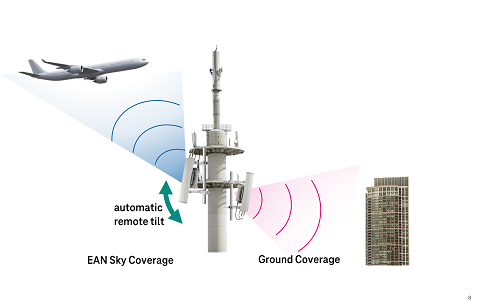Tweaking EAN’s Radio Network
In the last edition of our EAN Tech Update series, we explored how the deployment of a state-of-the-art geo-redundancy solution has further enhanced our European Aviation Network (EAN) inflight broadband service. This time, we look at recent efforts to improve our EAN radio network.
Traditional radio network planning focuses on population coverage to provide connectivity and performance in both urban and rural locations. Typical optimization criteria include hotspots, micro-cells, overlay networks, deep-inhouse penetration and macro coverage – all of which are focused on ground coverage.
However, EAN’s ground network design is unique in its nature, because we are evolving from traditional 2-dimensional ground coverage and need to guarantee an equivalent 3-D service that covers the airspace used by planes. In addition, new design principles had to be considered, as aircraft flight routes don’t necessarily align with populated regions. That’s why area coverage is a much more relevant concern than population coverage.
With our initial EAN network planning, customized radio penetration models have been applied to cope with those specific requirements. Supported by simulations and analytical studies, we derived an optimum scenario for the initial rollout. In 2020, after more than a year of being ‘on air’ with the live commercial service, many new EAN performance data sets became available. We used this real-life data to evolve our models and, where needed, fine-tune the radio setup.
Easy adjustments via remote tilt option
The most powerful and direct way to adjust our airspace coverage is the remote tilt option that has been built into our EAN antennas. Thanks to this feature, we were able to steer several of our antennas that needed fine-tuning by applying different uptilts centrally, without the need for a site visit or climbing any cell towers. Extremely useful and time-saving! It also means that the antenna elevation angles are not static - the more flights we see, the more data can be used, and tilts can always be adjusted to optimize airspace coverage. In addition, standard LTE software releases were rolled out to further enhance EAN’s radio network performance.

More bandwidth on board
On top of the radio optimizations, we also leveraged the latest mobile core technology to substantially reduce the bandwidth needed for signaling from the base stations to the mobile core(s) – often referred to as mobile backhaul. This, in turn, meant we could allocate even more bandwidth for the onboard connectivity enjoyed by our airline customers and their passengers.
Despite the COVID19 pandemic creating a number of challenges, from supply chain issues for hardware to restricted site access for our field personnel due to travel limitations, we also upgraded our existing EAN radio equipment to the latest state-of the-art Nokia products. The upgrade was successfully completed on time at the end of last year and the entire work was executed without any customer impact. This activity also laid the foundation for our future new technology rollout as the key elements are now hardware-ready for the next generation.
With the EAN radio network now in peak condition, we look forward to sharing a few more examples on how we improved EAN’s service availability for our customers. Stay tuned to the next edition of our EAN Tech Update Series for more details.
SOCIAL MEDIA